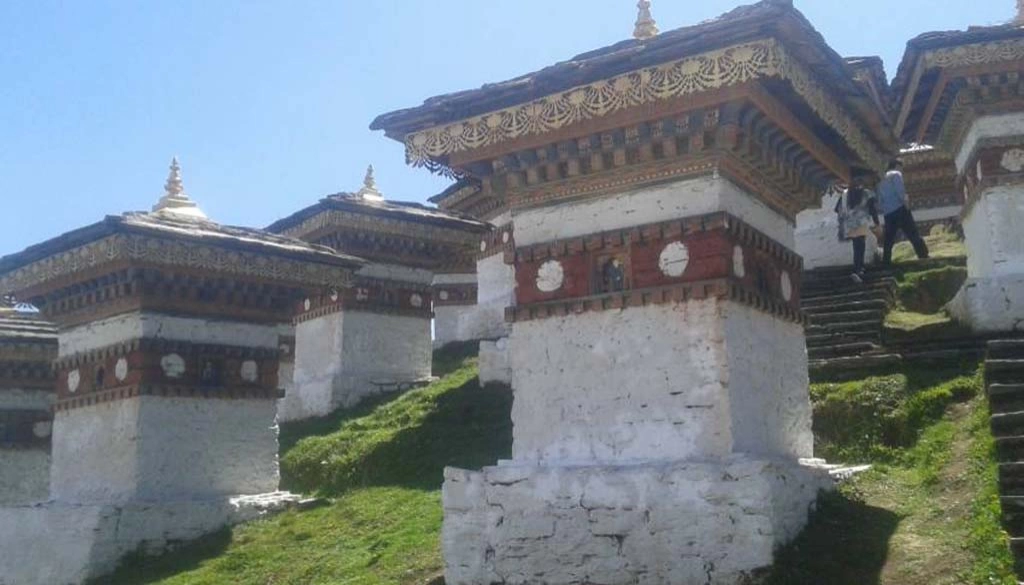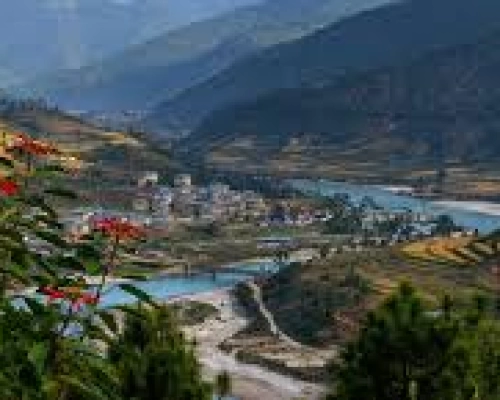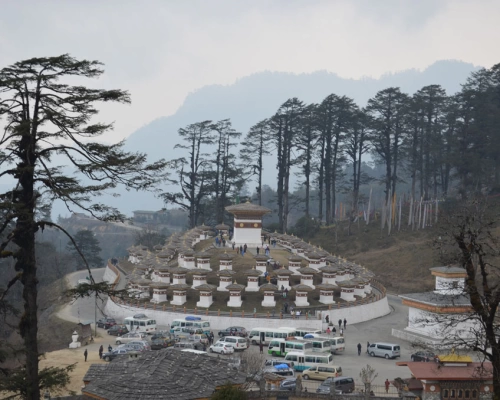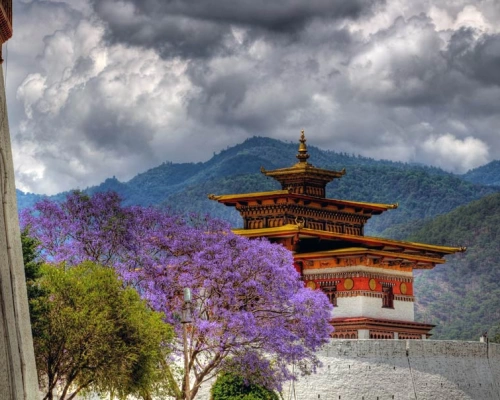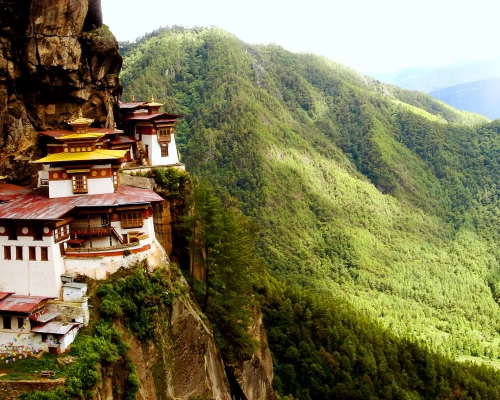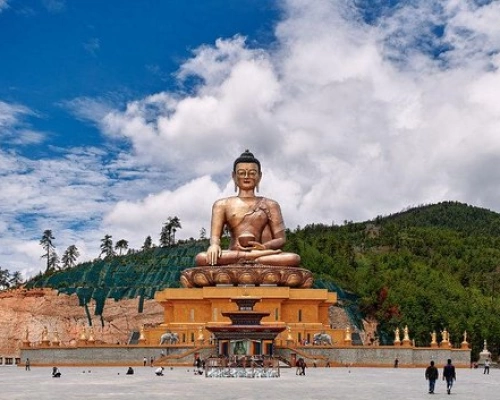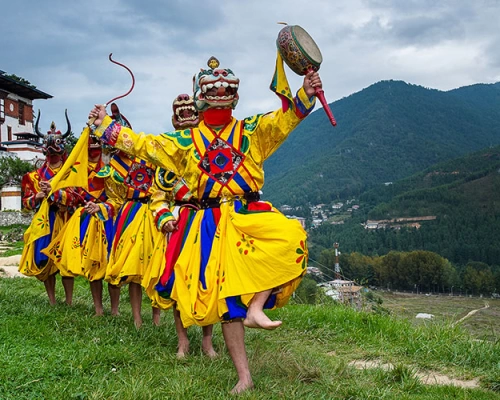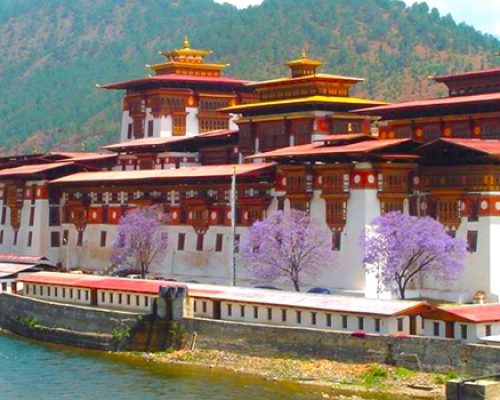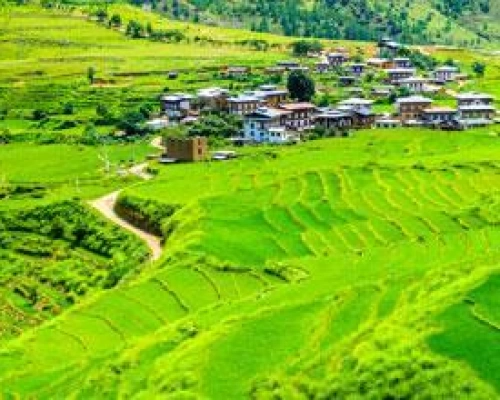The 8-day Spirit of Bhutan Tour is an immersive popular cultural journey through one of the world’s most captivating, cultural, and naturally rich countries. Starting in Paro, this tour gives an in-depth view into the ancient way of life and unspoiled Himalayan culture that still thrives in Bhutan today through the western valleys of Paro, Thimphu, Punakha, and Wangduephodrang.
Throughout the journey, travelers and visitors are accompanied by breathtaking views of the Himalayas, progressing simultaneously through Paro Dzong, Taktsang Monastery, also known as Tiger’s Nest, and Thimphu, including key attractions like Memorial Chorten, TashichhoDzong, and the weekend market. Most of these iconic landmarks are perched dramatically on the cliffside, offering expansive panoramic Himalayan sights and insider views of Bhutanese.
The overall tour is well-paced and allows you to savor all the unique highlights of Bhutan set in the diverse mountainous landscapes dotted with numerous monasteries, temples, chortens, historical fortresses, and extremely hospitable, open-hearted, and friendly locals. It is much delighting to discover the lively history of Bhutan as you stroll around the Ta Dzong Museum, Rimpong Dzong, Takstang Monastery (Tiger’s Nest), and others gradually leading you to Thimphu, the capital city of Bhutan, where ancient traditions blend harmoniously with modern Bhutanese life.
To conclude, the spirit tour of Bhutan is an unforgettable 8-day balanced cultural exploration, spiritual encounters, stunning landscapes, and experiencing incredible warm hospitality in Bhutan. Taking you from tranquil monasteries and ancient dzongs to serene valleys and authentic local life, this journey is a must to seize opportunity for those seeing the true connection to Bhutan’s tradition and natural beauty in the country also known as the Land of the Thunder Dragon.
What can you expect during the Spirit of Bhutan Tour?
The Bhutan Tour begins and ends with a scenically mesmerizing flight to Paro serving as the gateway that gradually approaches the capital city of the nation with a drive to Thimphu. After you arrive in Thimphu, the exploration usually starts in the morning after breakfast, around 7 am to 8 am.
It is an overland tour; therefore, driving along Bhutan and its notable monuments is going to be much more joyful, representing Bhutan’s unique culture, history, and natural beauty, added much by short to long side hikes, Bhutanese arts and crafts, local cuisines, and traditional villages with Bhutanese-style lodges and hotels.
Overall, the Spirit of Bhutan tour offers a comprehensive experience, giving you a well-rounded introduction to day-to-day life in Bhutan alongside well-paced adventure and reward where the given factors come together, making it a special intake:
The Pristine Natural Beauty
Bhutan, nestled in the eastern Himalayas between China and India, boasts its unspoiled landscapes, awe-inspiring Himalayan mountain peaks, lush valleys, and ancient forests. The country, also renowned as the Land of the Thunder Dragon and deeply rooted in Buddhist heritage, features one of the most untouched countryside, a dreamland for nature lovers.
The country supports a wide range of flora and fauna, including elusive species like the black-necked crane, while the shimmering tranquil lake paves the way through verdant forests and colorful rhododendrons provide a touch of serene vistas.
Across the globe, the country is taken into consideration for its new approach to development primarily concerned with Gross National Happiness over economic increment with its strong commitment to preserve its environment and culture; several dedicated for conservation only, such as Haa Valley or Gangtey Monastery, take a short hike or nature walk.
Further, Bhutan also limits the number of tourists every year, promising a unique perspective and a rare and authentic experience, making it a haven for those seeking amazing tranquility in the lap of the Himalayas.
An enlightening cultural and historical immersion
During the Bhutan tour, to embrace the spirit of the land, you will visit several sacred sites like Tiger’s Nest Monastery (Paro Taktsang), Punakha Dzong, Thimphu’s Memorial Chorten, and get to explore Bhutanese craftsmanship at Thimphu’s Folk Heritage Museum, Handicrafts Emporium, and many more.
Thimphu has one of the world’s tallest sitting Buddha statues cast in bronze in China at Buddha Point, depicting Buddha at the moment of his enlightenment sitting in Bhumisparsha mudra overlooking the hills and Himalayas of entire Bhutan and across its capital. In addition, Changangkha Lhakhang is remarked as one of the oldest monasteries in the capital city, with its high walls and prayer wheels to get blessings.
Similarly, the journey to Phobjikha Valley lets you make way through the adventurous pass that commemorates Bhutan’s victory over Indian insurgents in 2003, offering spectacular sightings of snow-covered 7,000-meter peaks, including that of Gangkhar Phuensum, Gantey Gompa, the oldest Nyingmapa Temple in western Bhutan, housing the ninth reincarnation of the Gangtey Tulku. This monastery also hosts the Black Neck Crane Festival, providing one of the best experiences.
Like this, a tour to Bhutan offers an enriching first-hand cultural and historical experience, visiting several holy monasteries back and forth, traditional festivals, and majestic dzongs. Travelers and visitors get to marvel at deep Buddhist traditions, colorful masked dancing festivals, exploring the ancient local markets, and art forms like weaving and wood crafting, adding much to the profound sense of self-reflection, mindfulness, and genuine connection to the spiritual realm.
Immeasurable spiritual experience
Much to the meditational aspirants delight, the Bhutan Tour offers the opportunity to practice meditation with monks amidst the serene presence of prayer flags usually fluttering in the mountains in sacred monasteries of Tiger’s Nest and temples like Kyichu Lhakhang and Chimi Lhakhang (Fertility Temple).
As the country is highly influenced by Buddhism, it would be a soul-purifying experience as you get to observe holy rites, rituals, and spiritual festivals in several gompas, monasteries, and temples filled with the pleasing aroma of butter lamps, burning incense, and holy chanting mantras, giving you a transformative environment to see within yourself find the purpose of your being and connecting you well to Bhutan’s tranquil and sacred atmosphere.
Adventure and outdoor activities
Trekking, hiking, and adventure are quite popular forms of tourism in Bhutan, to cater to the needs of the respective fans. You can enjoy several outdoor activities, such as a hike to the most famous cultural site, Tiger’s Nest Monastery to Druk Path, or a Snowman Trek with a 360-degree complete Himalayan view, which is adventurous and rewarding.
Moreover, you can also go for whitewater rafting, kayaking, mountain biking, and birdwatching as well, particularly in the Phobjikha Valley, where the widely stretched forests and protected areas offer wildlife spotting, appealing to adventurers across the globe.
Sustainable and eco-friendly tourism
Bhutan is one of the countries that has done its best to conserve its natural and cultural beauty to the fullest, be it by regulating the classes that teach the Bhutanese way of life, culture, traditions, dances, music, rites, and rituals or separating at least 70% of the country as a forest area. There are strict policies for maintaining its carbon-negative status, even allowing only a limited number of visitors each year.
The country highly promotes high-value, low-impact tourism, minimizing the risk of environmental degradation, along with authentic culture and traditional dress (Gho for men and Kira for women) still worn daily miles away from the hustle and bustle of commercialization, guaranteeing exclusive experience.
It would be wonderful to be involved in environmentally friendly activities to promote the conservation of the environment and wildlife in the region and express cultural respect for the wonderful and unique Bhutanese culture.
Why is the 8-day itinerary the best route for the Bhutan Tour?
The 8-day itinerary for the Nepal Bhutan Tour begins in Kathmandu, a backpacker's first choice with not less than seven UNESCO World Heritage Sites. The journey offers a variety of activities such as wildlife safaris, pilgrimages, boating, and kayaking, along with cultural diversity, traditional lifestyles, and unique art and architecture.
The tour takes the clients to natural destinations such as the Taktsang Monastery, Punakha Dzong, and Thimphu and drives further into the countryside to taste the real Bhutan without cultures feeling rushed and/or overwhelmed with largely balanced stimulation and rigors of the environment. Hence, the 8-day itinerary is considered the best route for the Bhutan Tour: big enough to provide sufficient time to experience the real cultural flavor of the Himalayan region but small enough to enable people to do a time-effective tour and trek.
Further, at Adventure Himalayan Travels and Treks, you can get your customized itinerary set as per your needs, preferences, fitness levels, and the niche of your interests. Contact us now for a tailored, private, group, or family tour to Bhutan, Tibet, India, and Nepal!
Group cost for 8-day Spirit of Bhutan 2024/2026
Though there can be significant variation on the overall Bhutan Tour package cost for the year 2024/2025 based on the number of travelers and visitors, the specific tour season, mode of transportation, and accommodation used, your personal choices on meals we at ATH&T are offering a group discounted price which is:
- USD 2,590 for 1-3 pax
- USD 2,475 for 4-6 pax
- USD 2,375 for 7-10 pax, and
- USD 2,275 for 11-14 pax
Generally, our Bhutan Tour Package cost includes all the government taxes, meals, accommodation, transportation, and entrance fees to major sites in Bhutan, along with the local guide's salary, meals, accommodation, other necessities, and insurance.
